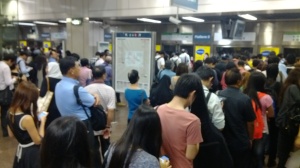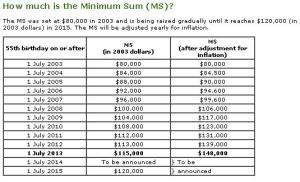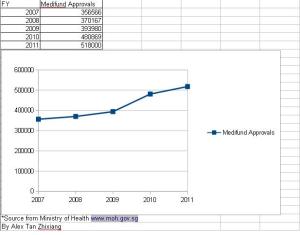Tan Ruiwen
[Alex Tan Zhixiang i think you need to consider that Greece, Spain & Slovakia are all countries that are suffering problems that might appear similar to Singapore, but are actually quite different. Their governments are basically broke, and are borrowing large sums of money to sustain their economy. That is quite unlike our situation.
I’m not saying that we apply the old adage of “if it ain’t broken, lets not fix it”. Your proposals neatly sum up the grouses of many Singaporeans. They all sound great. its a utopia. But you have to be pragmatic about it. I will give you some examples:]
It is funny how rich you think Singapore is when you don’t even know we are one of the countries with the highest debt as a percentage to our GDP. Do you really think our economy is sustainable? Our situation is worse than them, because the PAP trivialize on the people’s freedom and money.
The system is broken, fix it. My proposal is fully pragmatic until you are able to prove otherwise.
[1) Your nationalized insurance scheme sounds great. everyone would not complain about free healthcare. But the problem is funding, and application. Take the UK’s NHS system for example. I’m sure you, having studied at Bradford, know first hand the problems of having a free national health regime. Long waiting times and poor treatment are all hallmarks of state-sponsored healthcare. Bureaucracy has a habit of tearing things apart.]
1) When it comes to the issue of funding, you like the PAP, are putting the horse behind the cart. The question should not be whether if there is enough funding, but rather, the question is whether if the people could afford treatment. Welfare like unemployment benefits and nationalized insurance are matters of morality and indications of a first world society. Could I bring across a scenario to you: If you are a father and your kids are hungry, do you restrict your kids’ intake by your salary or do you go out and earn more for your family? My answer to you is to find the funds, whatever it takes to ensure your people have affordable healthcare.
Trim the defence budget, stop defence purchase if necessary, healthcare comes first.
2) You mention nationalizing the transport system. Sounds great too. However our current transport system is kinda already nationalized. Most of SBS and SMRT are owned by Temasek one way or another, and therein lies the problem – a lack of competition. As such, they are able to fix rates as and how they want it to. In any case, i honestly don’t see a problem with our transport network. Other countries are trying to copy us (e.g. Malaysia). We have prevailing subsidies for the elderly, and students. The recent proposals by SMRT to expand our train network all over our island, and the opening of numerous new stations has brought alot of convenience to Singaporeans. Yes there are problems, but so far, i would say its okay.
2) Do you even know how much SBS and SMRT are making? SBS and SMRT are clocking tens of millions of profit every single year, recession or not. Contrary to what “experts” see, the lack of competition in this monopolies is not the problem, the problem lies with the Singapore transport market being too small for private competitions. Unlike overseas, we do not have an alternative to public transport. Private transport is reserved only for the 15% of the population who could afford a private vehicle.
[3) You mention scraping NS, having a complete professional army, and opening it to foreign nationals. All at a cap of 3% of annual GDP. Firstly, i refer you to our Singapore Budget 2013, which budgeted 3.3% of our GDP for Defence this AY. And this increase was explained by the Defence Minister to be due to acquisitions of hardware such as HIMARS & the Leopard 2, which were essential replacements of old systems. Further, I understand that you’re migrating, so you don’t feel the way that I feel, but I’m kinda uneasy about having foreign nationals, with no ties to my country, defending us. I’m already uneasy about the Gurkhas being here. What you’re proposing sounds like a way to outsource national defence, and the americans tried that in Iraq with Private Military Contractors. Look at what happened. I would love to delve into how it is our responsibility as Singaporeans to defend what is ours, but lets not go there, as it is not applicable to you.]
3) Hello, where did you get your 3.3% statistics?! Defence Budget for 2013 is 20% of GDP or $12.3 Billion. Don’t waste my time if you are not doing your due diligence.
You are uneasy about Gurkhas? Do you know that Lee Kuan Yew and the Ministers clearly trust them more than they trust you a Singaporean to guard their house? Please wake up your idea and look Chatsworth Avenue for goodness sake.
[4) Unions. I think we can agree on the point that Singapore’s survival depends on being a global player in a global economy. A large part of our revenue is derived from taxing companies- about double that of personal taxes, and it is the single largest contributor of wealth to our nation. Now, sure we have problems with regard to “exploitation of our countrymen”, but focus on the big picture: they are here, because we have a safe, and reliable workforce. there are statutory provisions in place to protect our workers, such as the workmen’s compensation act. Having unions of the old might take away this image of Singapore being safe, and reliable, and drive investors offshore. Note, I’m not saying we don’t allow our workers to air their grouses, but we can do it in better ways.]
4) Singapore is a global player in the global economy is what sense? Elaborate.
The big picture is the MNCs needed us too not the other way round. The relationship is bi-directional and mutual, please grow some pride and stop sounding as if we are begging for them to come here. What statutory provisions are there to protect our workers from not getting paid on OTs, working pass the weekly 72 hours limits, depression of salaries and many other unscrupulous employment rules? MOM is useless and NTUC is the same.
You have been brainwashed into thinking the bads of unions. If unions are so bad, why do Malaysia, Taiwan and Hongkong faring better than Singapore? Even Thailand, Burma and Vietnam which have seen much turmoils in the recent years are also doing well with the presence of unions. Shouldn’t MNCs avoid them like plague? The PAP argument that unions scare off investors is hogwash, and you, are the hogwashed.
[So you say that we shouldn’t all complain about your proposals, and actually try and make something work. Well, here are my proposals-]
[1) I agree with your point on HDB Flats. I think the government should sell them at cost to locals, because at the end of the day, it is social housing. I would say that the current ABSD regime has hit alot of foreign speculators of property in Singapore hard. Ask any property agent. They will tell you that the market is cooling rapidly. That’s one possible way to deal with housing in Singapore.]
1) Ok so what is your proposal aside from agreeing with me?
[2) With regard to “Engines of Growth” for Singapore, i have a problem with High Tech Manufacturing being the leader. The reason being that China has a) more land space, b) more cheap labour, c) more cheap electricity to do so. Our wafer fab plants are already facing problems due to rising costs of operations. Instead, I believe we are very suitably positioned to act as a market leader for the financial industry. I point towards foreign perception of Singapore being safe, reliable and efficient. These are things that the financial world wants, and we can deliver.]
2) Going by your logic, Germany and France are already bankrupt by the direct competition of the cheap labor in Slovakia, Hungary, Poland and Eastern Europe.
Speaking about financial market, Singapore is a big joke. We flopped in the Malaysian stock exchange, S-chips and now the recent scandal of the 4 penny stocks. Oh please obviously you do not invest and know nuts about Finance. I am an engineer, I don’t study Finance, but I can tell you Singapore’s financial image is very poor. Go ask the traders, we all know how sloppy accounting standards here can be. Our Singapore Exchange (SGX) are desperate for companies to list, it is such an embarrassment. Perhaps you should stop reading the Straits Times painting such a wonderful picture for you.
[3) the “Foreigner” issue. let’s be honest. every country has this problem- Germany, Australia, the UK… everyone. Nobody likes it when someone from outside the community comes in, especially when people don’t understand their culture and practices. I’m sure you will face the exact same problems when you emigrate. But this does not mean that we completely shut them out. I think foreigners have a part to play in Singapore. I’m just worried because their large purchasing power has caused our cost of living to shoot up. Take for example a foreigner’s acquisition of a coffeeshop at $10 million dollars (which can happen). Commercial space is open to foreigners to own. They would need to charge rent of at least $5000 – $8000 in order to gain back what they put in, which would correspondingly drive up the price of food for locals. Basically, i think the biggest problem with foreigners is their ability to purchase property, which has a huge impact on the lives of locals. I think the ABSD, and Commercial Property Tariffs should be re-examined.]
3) You are talking nonsense, this foreigner issue is exclusive and unique only to Singapore based on 3 criteria no other countries have:
a) Foreigners is at 40%. UK is not even 15% and there they are kpkb-ing already. Please lah go read first before you even talk to me, this is really a waste of time of me throwing statistics at your face.
b) We have National Service for Singaporean males. New citizens, PRs and foreigners are excused. This is one big inequality that can never be addressed.
c) We are overpopulated. UK, US, Germany, Australia do not see overcrowding in public transport, failing infrastructures and most important of all: Depression of Wages. Why do you like to compare with these OECD countries in terms of foreigner population, but when we talk about Minimum Wage, Universal Healthcare and Welfare you shun away?
[right. i have alot more but i’m tired. by the way, did you run under the banner of the reform party during the last GE? As a sidenote, I declare that I’m generally politically apathetic. I see myself as a Singaporean, and i support policies, not parties. Your policies are premised on good intentions, but i feel that alot of them fail to see the bigger picture. As Sean Liew said- if you put them all together, they might cause Singapore to fail. Its nothing personal, its just economics.]
You are tired from writing such a short article? Yes I ran under RP during GE, but I am not their member. If you are politically apathetic, it means you are a PAP supporter. You like many other PAP supporters, fail to see the big picture and sustainability of the existing system. Singapore is sinking and falling already for your info, many old guards have spoken up, so are many respected professionals and independent writers like me. It is nothing personal, this is not economics, you are just a kid.













